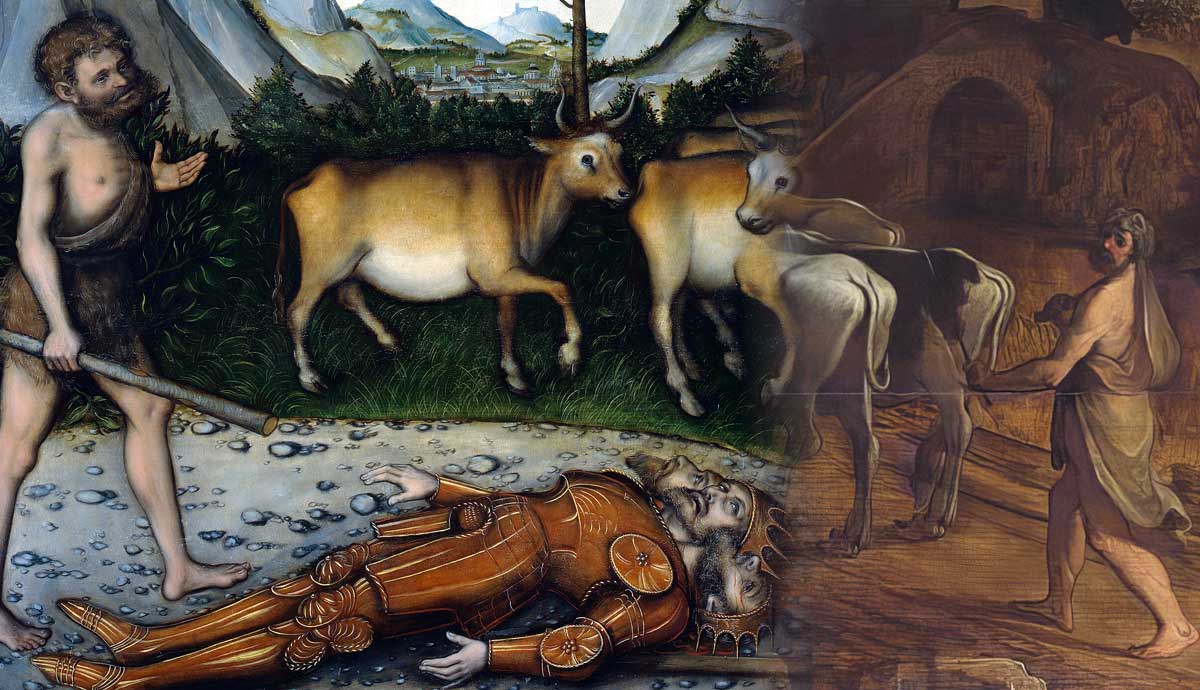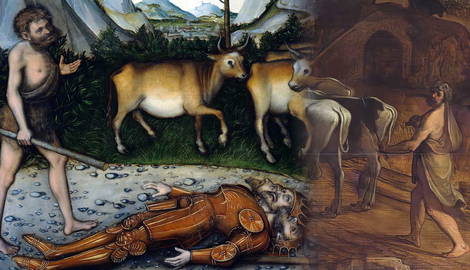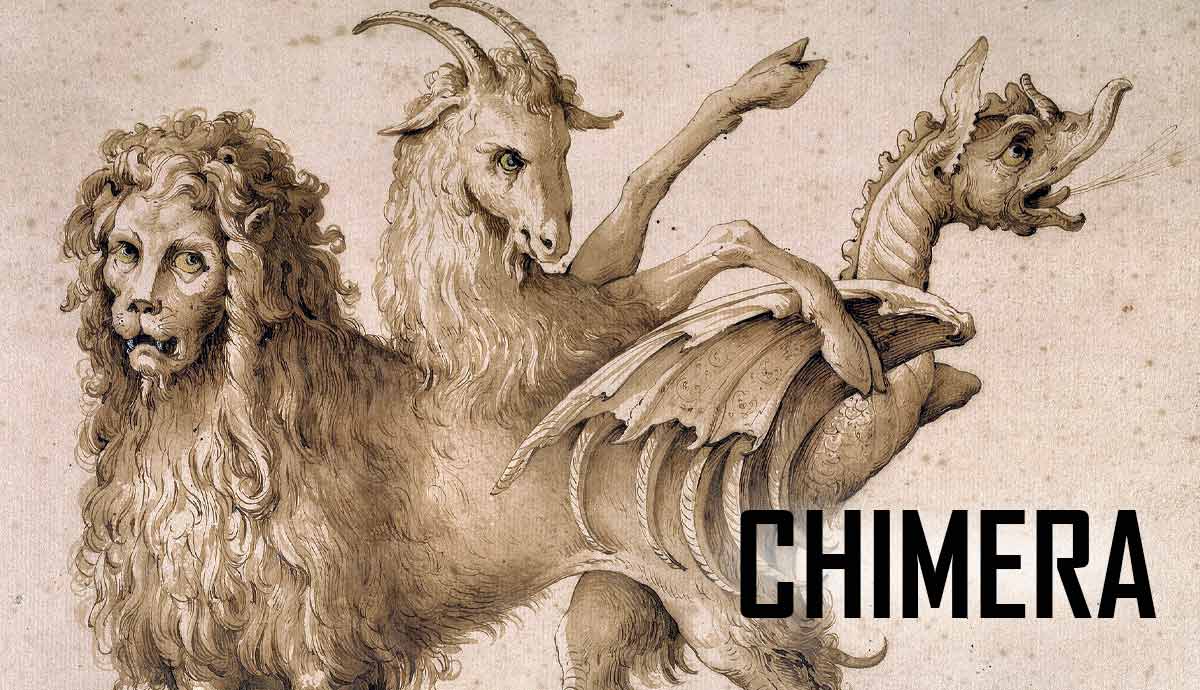
King Eurystheus tasked Heracles with stealing the cattle of the three-headed giant Geryon, ruler of Erytheia, an island at the westernmost edge of the world. During his journey to the mysterious island, Heracles crossed the scorching Sahara Desert and argued with the god of the sun. Finding the island was not the only issue, as Geryon’s cattle were guarded by the two-headed dog Orthus and the giant Eurytion, the son of Areas. Learn how Heracles stole Geryon’s cattle and the trials he endured to get them back to Eurystheus.
The Journey to the Edge of the World

For Heracles‘s tenth labor, King Eurystheus commanded the hero to journey to the edge of the known world and steal the sun-kissed cattle of the three-headed giant Geryon. The task that lay before Heracles was truly daunting. Everyone knew that Erytheia was located at the edge of the world, where the setting sun met the distant western horizon. Yet, the exact location of the island and its distance from the mainland were unknown.
The island of Erytheia, also known as the “red one,” was one of the three Hesperides (the Nymphs of the evening and the golden light of the sunsets), which would play a role in one of Heracles’s future labors. The exact location has been a subject of debate among both ancient and modern scholars. All agree it was an island in the Atlantic Ocean, perhaps found along the western coast of the Iberian Peninsula or Morocco, such as the island of Gades (modern-day Cádiz), the Canary Islands, or Madeira.
Neither Heracles nor Eurystheus knew how to find the island, and with no maps or even rumors about how to locate it, Heracles decided to begin traveling in a western direction until he hopefully found it. Rather than traverse southern Europe to go west, Heracles started his journey in Egypt and traveled west across the scorching Libyan desert to find the fabled island.

Heracles’s journey across Libya and its relentless, unforgiving desert pushed the hero’s endurance to its limits. According to Greek myth, the sun, pulled by Helios in his golden chariot, came so close to North Africa that it permanently scorched and radiated across the land, creating the Sahara Desert.
Years before Heracles, Helios’s son, Phaethon, asked his neglectful and uninvolved father for a gift. Without thinking, Helios agreed to give his son anything he asked for. Many fables and myths hold valuable lessons, and one such lesson is that the gods should only grant a mortal’s wishes if they know exactly what they want beforehand. Helios realized this lesson too late, as he heard Phaethon’s wish: to drive the chariot of the sun unaided.
The sun god begged Phaethon to choose something else, as controlling the chariot of the sun was extremely challenging. The chariot, pulled by four horses named Aethon, Eous, Phlegon, and Pyrois, could cause catastrophic environmental damage to the world below if not appropriately handled. However, Phaethon insisted, and Helios was forced to grant his wish. Phaethon soon lost control of the chariot, causing extreme temperatures that froze and scorched the lands below. Zeus struck Phaethon with a thunderbolt to stop the chaos, causing the poor youth to plummet to his death, ending the destruction and allowing Helios to regain control.

As Heracles continued his arduous journey across the scorching lands of North Africa, his patience wore thin. The relentless heat, an everlasting repercussion of Phaethon’s folly, pushed him to his limits. In a fit of rage, he turned his anger towards the cause of his troubles: the sun.
He unleashed deadly arrows at the sun, each coated in Hydra venom. As Helios, oblivious to the impending danger, drove the sun in his chariot, several of Heracles’s arrows came dangerously close to striking him. The venom of the Hydra, while not lethal to an immortal, promised unimaginable and unending pain. Fearing such a fate, Helios appeared before Heracles and pleaded with him to stop. However, consumed by his anger, Heracles refused to yield unless the sun god made the desert less inhospitable or if he aided him on his journey to the island of Erytheia.

After some persuasion, Helios agreed to assist Heracles on his journey by giving him his golden cup. Every day, Helios would fly the sun chariot across the sky from his golden palace in the east to the Kingdom of Oceanus in the west. Once he landed, Helios used his golden cup to sail throughout the night along the fast-flowing River Oceanus to return to his palace in the east in time to begin the cycle of the sun anew the following dawn. Heracles happily accepted Helios’s offer and reached Erytheia in less than a day, thanks to the golden cup.
The Giant Geryon and His Sun-kissed Cattle

Geryon the Giant ruled the island of Erytheia and was a unique figure in Greek mythology. When the hero Perseus beheaded Medusa, two creatures, Chrysaor and Pegasus, sprung from the gorgon’s severed neck. These brothers were the offspring of Medusa’s ill-fated relationship with Poseidon. While the winged horse Pegasus went on to have many adventures, Chrysaor settled down and married the sea nymph Callirhoe, daughter of the Titans, Oceanus and Tethys. The couple then bore Geryon, a three-headed and triple-bodied giant whom Hesiod describes as the strongest mortal.
Descriptions and depictions of Geryon vary, but all sources agree that he was a powerful and fierce giant with three heads. However, different artistic and literary depictions portray his three heads differently. Some describe Geryon as having a single body with three heads emerging from one torso. Others depict the giant as having three separate upper bodies attached to a single pair of legs. Other accounts suggest that Geryon had three distinct upper bodies that narrowed to a single waist and then branched into three sets of legs.
This unusual and cumbersome appearance led later writers to theorize that Geryon might have been mistakenly thought of as a single entity when he was actually three separate brothers who jointly ruled Erytheia.

Geryon was well-known for his prized, sun-kissed cattle. The island of Erytheia, near the setting sun at the western edge of the world, had an interesting effect on Geryon’s beloved cattle. Over time, the setting sun had stained the cattle’s coats, turning them red, reminiscent of the dusky sky. The cattle’s unique red coloring made them stand out from all other cattle in the known world.
To protect his rare and beloved sun-kissed bovines, Geryon hired Eurytion, the giant son of Ares, to be his herdsman, along with Orthus, the two-headed guard dog with a snake for a tail. Not much is known about Eurytion, but his canine companion Orthus was the brother of Cerberus, the infamous guardian of the underworld. Together, they were a formidable defence against thieves who sought to steal Geryon’s cattle.
Stealing Geryon’s Cattle

After traveling through the scorching desert and sailing across the rough waves of Oceanus in Helios’s golden cup, Heracles finally reached the world’s edge and landed on the shore of Erytheia. The hero had little time to collect himself, as the guard dog Orthus immediately caught the scent of an intruder and, barking in alarm, charged towards Heracles.
Still weary from his voyage, Heracles took out his trusty club and prepared for the attack. When the double-headed hound leaped toward Heracles, the hero swung his club with all his might, connecting with one of Orthus’s two heads, instantly crushing it. The painful howls of Orthus caught the attention of the giant herdsman Eurytion, who arrived just in time to see Heracles deliver the final blow to the guard dog’s remaining head.
Eurytion, the son of Ares, was furious about the death of his loyal companion and charged at Heracles to attack him. Heracles pulled his club out of the now-crushed remains of Orthus and rushed at the giant with a mighty battle cry. Heracles evaded Eurytion’s initial attack and used his club to sweep the giant off his feet, causing him to tumble. Before Eurytion could stand up, Heracles hit the giant’s head with explosive force, ending the last line of defense between him and Geryon’s cattle.
With the cattle’s guardians now defeated, Heracles found the red-coated cattle grazing in a nearby field and began driving them back to the golden cup. While Heracles corralled the cattle, Menoetes, the herdsman of Hades who often let his cattle graze on Erytheia, saw what Heracles had done and reported everything to Geryon. Upon learning this, Geryon prepared for battle by donning his armor and weapons and charging toward the interloper who dared to steal from him.

Heracles, nearly exhausted from his challenging night of sailing and his encounter with the cattle guardians, took out his bow and readied an arrow coated in Hydra venom as he heard Geryon approaching. When Geryon came into view, dressed in magnificent armor, Heracles let loose three arrows, hitting all three of the giant’s heads. The Hydra venom affected Geryon more slowly due to his unique physiology. Geryon pressed on despite the painful torment of the Hydra venom burning through his body. Heracles unleashed more arrows, eventually causing Geryon to stumble and collapse dead just a few meters away from the hero.
After defeating Geryon, Heracles secured the cattle and prepared for the long journey back to King Eurystheus. However, Heracles’s journey back home was just as challenging and eventful as his journey to the island at the edge of the world.
Returning Home With Geryon’s Cattle: Pillars of Heracles

There were 1,000 cows in Geryon’s resplendent herd. Now that Heracles had defeated their owner and guardians, he had to figure out how to safely move all of them from the edge of the world back to Eurystheus in the Peloponnese. It took Heracles several trips to move all 1,000 cows from the island to the mainland in the golden cup of Helios.
After Heracles successfully transported all 1,000 cattle to the mainland, the hero created a monument to celebrate his long and eventful journey. Where the Mediterranean meets the Atlantic, Heracles erected two pillars on the boundaries of Africa and Europe as markers to commemorate his trip to the westernmost limits of the known world.

Historically, these monuments, known as the Pillars of Heracles, were called Mons Calpe and Mons Abyla. Calpe, the northern pillar, is now the Rock of Gibraltar, while Abyla, the southern pillar, is either one of the peaks of Mount Jebel Musa in Morocco or Mount Hacho in Ceuta, Spain.
Alternatively, Homer claimed that Heracles constructed these pillars during his journey to the island of Erytheia. When he reached the western edge of the Mediterranean, he encountered the Atlas Mountain range, blocking his way to the Atlantic. Instead of climbing or traveling around the mountains, Heracles used his supernatural strength to split the offending mountain in two, connecting the Mediterranean and Atlantic seas and allowing him to continue his voyage to Erytheia.
Heracles took months to get the cattle back to Eurystheus. The hero safely drove them through the Iberian Peninsula and across southern France. However, Heracles encountered difficulties when he and the cattle reached the Italian peninsula.
Returning Home With Geryon’s Cattle: Land of the Bull

The first challenge that Heracles encountered occurred in the region of Liguria in northwestern Italy. While he allowed the cattle to feed and rest, two sons of Poseidon noticed the red-coated cattle and attempted to steal them. Fortunately, Heracles caught and killed the two thieves before they could escape with any of the cattle.
Heracles’s next encounter occurred when he decided to let the cattle rest and graze near a hill in the central region of the peninsula. This unassuming hill would later be known as Aventine Hill, but during Heracles’s time, the nameless hill was inhabited by Cacus, a fire-breathing giant.
Cacus, the son of Hephaestus, was a savage giant who terrorized the locals by feasting on human flesh. He resided in a cave on the nearby nameless hill and had a disturbing habit of nailing the heads of his victims to the entrance of the cave. Cacus stole some of Geryon’s cattle while Heracles was asleep, dragging them by their tails in reverse, reminiscent of how Hermes once confounded Apollo by stealing his cattle.
When Heracles awoke and found the cattle restless and pointing toward the nearby hill, he grew suspicious and investigated. Heracles soon realized that some of the cattle had been taken. Enraged, Heracles searched the hill and discovered Cacus’s cave. He then entered the cave and confronted the fire-breathing thief. Heracles and Cacus fought for some time, but ultimately, Heracles defeated the giant by strangling him so hard that his eyes popped out of his head.

Heracles’s final challenge on the peninsula occurred along the southern coast near Reggio di Calabria. While the cattle grazed, one roguish ox escaped from Heracles and ran across the peninsula before swimming to the island of Sicily. The bull was found by the island ruler, Eryx, a son of Poseidon, and added it to his herd.
Heracles left Geryon’s Cattle with Hephaestus while he searched for the missing bull. After weeks of searching, he found it in Eryx’s herd. The King refused to give up the bull and challenged Heracles to a wrestling match for it. Heracles accepted, easily defeated the King, and took the ox back to the mainland, reuniting it with the rest of the herd. According to some accounts, the native Etruscan word for the bull was “italus,” and the peninsula was named Italy (Land of the Bull) after this renegade ox that Heracles chased across the peninsula to Sicily.
Returning Home With Geryon’s Cattle: The Final Stretch

After a tumultuous journey through the Italian peninsula, Heracles safely drove all 1,000 cows across the Dalmatian coastline and into the familiar Thracian countryside. Despite all the challenges, he managed to keep Geryon’s cattle safe and secure. This achievement infuriated Hera, the Queen of Olympus and Heracles’s long-time foe.
As Heracles approached home, Hera unleashed an army of gadflies to torment him and the cattle. The painful bites of the gadflies caused the cattle to panic, buck, and stampede in all directions. Heracles could not calm or control them even with all his strength as the gadflies attacked.
It took Heracles months to gather the scattered cattle. To worsen matters, Hera commanded Strymon, a Thracian River god, to flood the area, preventing Heracles from crossing into Greece. Heracles piled countless rocks into the river, enabling him to cross but also making it unnavigable.

Just shy of a year after beginning his tenth labor, a battered and exhausted Heracles arrived at the city gates of Tiryns to present Geryon’s Cattle to King Eurystheus. Stealing Geryon’s Cattle had been one of the most challenging tasks Heracles had ever undertaken. It was a feat that should have been praised and celebrated. Yet, after seeing the magnificent red-coated cattle, Eurystheus’s expression turned sour.
The King’s servants noted that there were only around 700 cattle instead of the reported 1,000. Despite Heracles’s best efforts, he could not secure all 1,000 after Hera sent the gadflies, and there were still 300 red-coated cows roaming the Thracian countryside. This failure, combined with Heracles’s supposed misconduct during his second and fifth labors, led to Eurystheus officially announcing that Heracles’s original ten tasks would increase to twelve.

When Heracles first began his journey of redemption, he was told by the Delphic oracle to undertake all his trials without complaint or protest. It was promised that if he did so, he would be rewarded with immortality. Whether or not this was a gift the hero truly desired is unknown, but despite the crushing disappointment at hearing that his atonement was far from over, he never showed it. Quietly raging at his plight, the stoic Heracles turned to Eurystheus to await instructions for his eleventh labor: Stealing three of the golden apples of the Hesperides.








